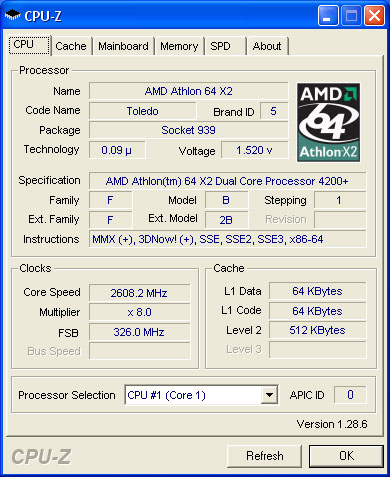Overclocking the 4200+
Like other "performance-rated" AMD processors, the 4200+ is locked at the top. In this case the 4200+ multiplier is fixed at a maximum of 11. As with all AMD Athlon64 processors, however, you can select ratios below 11. Only the AMD FX chips are unlocked at both the top and bottom of their range.| Front Side Bus Overclocking Testbed | |
| DFI LANParty nF4 SLI-DR | |
| Processor | Athlon 64 x2 4200+ (2.2GHz, 512KB Cache each core) |
| CPU Voltage | 1.55V (default 1.30V) |
| Cooling | Thermaltake Silent Boost K8 Heat sink/Fan |
| Power Supply | OCZ Power Stream 520W |
| Memory | OCZ PC3200 EL Platinum Rev. 2 (Samsung TCCD Memory Chips) |
| Hard Drive | Seagate 120GB 7200RPM SATA 8MB Cache |
| Maximum OC (Standard Ratio) |
245x11 (Auto HT, 2.5-3-3-7, 1T, 2.8V) 2695MHz (+22.5%) |
| Maximum FSB (Lower Ratio) |
326x8 (2608MHz) (Auto HT, 2.5-4-3-7, 2.9V) (1:1 Memory, 1T, 2 DIMMs in DC mode) (+63% Bus Overclock) |
For an early x2 Athlon64 processor the overclocking performance on air is impressive. The next speed step of 2.4GHz (4600+) was easily reached, and we moved on past the next logical step of 2.6GHz to 2.7GHz. This is faster than any of the currently available Dual-Core Athlons. We should mention that 240x11 (2.64GHz) was an extremely easy and stable reach. That speed required just 1.45V, was exceptionally stable, and ran quite cool. The last 55MHz required a great deal more voltage and generated a lot more heat. For day in and day out the 240 setting (2.64GHz) would be our choice with this CPU (stock 2.2GHz) on air.

In testing for the highest CPU Frequency a new record for TCCD memory was achieved. 326 or DDR652 is the highest yet achieved with these double-sided 512MB OCZ PC3200 EL Platinum Rev 2 modules. This improved performance of the TCCD memory is likley the result of an improved memory controller on the dual-core CPU.










53 Comments
View All Comments
Googer - Thursday, June 23, 2005 - link
Correction:This is not an Apples to Apples compairison, This article should have compaired a 90nm Venice 2.2GHz 512k to a Manchester Dual Core 512k 2.2Ghz. Why was the 4000+ used as the compairison in an overclockability aricle? It does not even come from the same die.
Googer - Thursday, June 23, 2005 - link
This is not an Apples to Apples compairison, This article should have compaired a 90nm Venice 2.2GHz 512k to a Dual Core 512k x2 2.2Ghz. Why was the 4000+ used as the compairison for overclockability aricle?Googer - Thursday, June 23, 2005 - link
Lets get First POST Cr*P out of the way